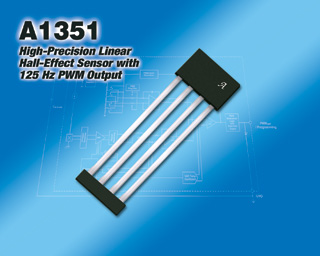案例中心
\ NewsNews & Events
A1351: Allegro MicroSystems, Inc. Introduces A New High-Precision Linear Hall-Effect Sensor
Worcester, MA – March 6, 2008 — Allegro® introduces a high precision, programmable linear Hall-effect sensor with a 125 Hz pulse width modulated (PWM) output. This new device is targeted at the automotive and industrial markets in current and position sensing applications that would benefit from a thin package and PWM output.
The duty cycle (DC) of the PWM output signal is proportional to an applied magnetic field. Allegro’s A1351device converts an analog signal from its internal Hall sensor element to a digitally encoded PWM output signal. The coupled noise immunity of the digitally encoded PWM output is far superior to the noise immunity of an analog output signal. A simple RC network can be used to convert the digital PWM signal back to an analog signal.
The BiCMOS, monolithic circuit inside of the A1351 integrates a Hall element, precision temperature-compensating circuitry to reduce the intrinsic sensitivity and offset drift of the Hall element, a small-signal high-gain amplifier, proprietary dynamic offset cancellation circuits, and PWM conversion circuitry. The dynamic offset cancellation circuits reduce the residual offset voltage of the Hall element. Hall element offset is normally caused by device over molding, temperature dependencies, and thermal stress. The high frequency offset cancellation (chopping) clock allows for a greater sampling rate, which increases the accuracy of the output signal and results in faster signal processing capability. An internal filter of approximately 50 Hz is used to achieve ~10 bits of output resolution.
Allegro’s A1351 device is supplied in a thin 4-lead SIP (K) package.

 收藏本站
收藏本站
 当前位置:
当前位置:








